Project Log: Sunday,
January 10, 2010
Home Page >
The Project >
Project Logs > 1/10/10 |
After a much-needed break
following the end of Phase I, which coincided nicely with
holiday season and some other commitments, my thoughts returned to the project
shortly after the start of the new year--not that the
project was ever out of my mind.
With ongoing paint
work in the other shop bay, which would continue over the
next couple weeks, I felt I couldn't yet contemplate a
wholesale return to the next steps, which would involve
additional preparations for and eventual reconstruction of
the damaged stern quarters. Anxious to determine
exactly how I'd proceed, I decided to drill a number of core
samples in the aft sections of the boat--and adjacent
areas--to help me determine the true condition of the
laminate that remained in place.
Working from inside
the boat, where the condition of the laminate was most
visible, I drilled 21 core samples with a 1-3/8" carbide
hole saw: 21 because I inadvertently re-used #13,
which I subsequently relabeled 13A and 13B. I chose
the test holes' positions based on the visual condition of
the laminate in various areas, and also in several seemingly
undamaged areas to serve as controls and as a definition to
the scope of the damaged areas. In each case, I
numbered the hole and its corresponding plug for future
reference.
In addition, there were 6 holes left over
from through hull fittings that had been installed; I
labeled these accordingly as well: TH-1, TH-2, etc. |
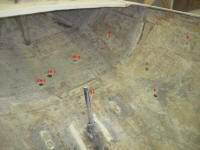
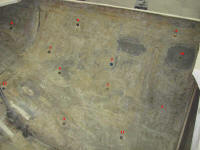
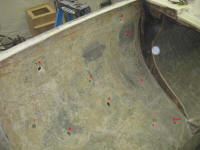
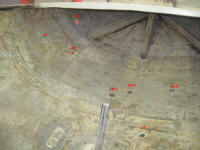
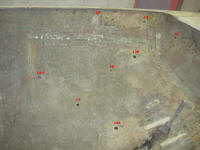
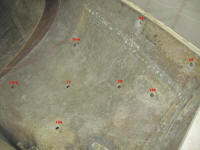
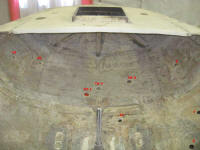 |
I also transferred the
labels to the outside of the boat for additional location
reference. |
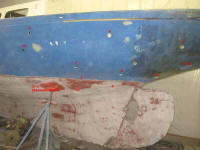
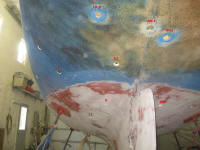
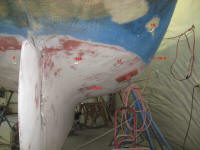
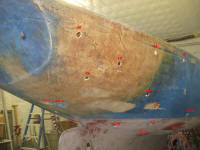 |
In general, the core samples few real surprises.
Where I thought the laminate might be badly damaged and
partially delaminated, it was; where I thought it would be
sound, it was. Several of the cores indicated more
hull thickness than I'd anticipated (most notably in the
bottom sections, closer to the keel), while I was surprised
at how thin the remaining laminate was in some of the other
areas, where the thickness had apparently been more
significantly reduced by various grinding efforts, and
possibly consumption during the fire itself.
Here are
all 21 core samples together: |
 |
Below, please find individual photos and preliminary
comments on each core sample taken. In each case, the
photos show both sides of the core sample, and a view of the
adjacent hull area around the sampling area. Where the
core sample came out in two pieces, I've included views of
both sides of each section, as well as a stacked view
showing the pieces in their correct orientation to each
other.
Please reference the labeled wide-angle views
above to determine the location of each core sample.
|
1: Taken from a known bad area.
Total thickness: about 1/4". The innermost layer
of material (which seemed to be a layer of mat from the
mat/roving layup) delaminated from the remainder of the
sample during removal, but the outer layers appeared sound. |
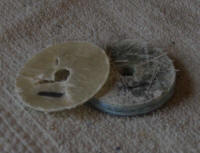
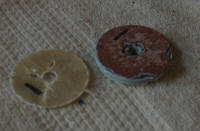
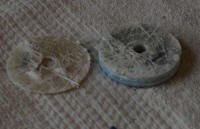
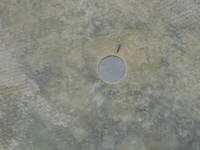 |
2: Taken from a known bad area. Total
thickness: about 1/4". 2 layers of roving from
the inside of the sample delaminated from the outer section
during removal. |
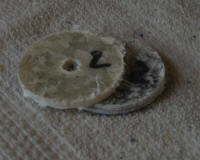
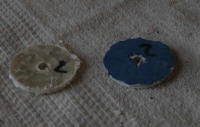
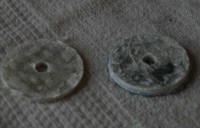
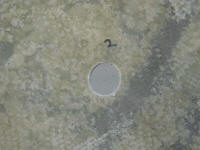 |
3: Taken near the forward edge of the affected
area on the port side, as a sort of control. Total
thickness: 5/16" +. No delamination during
removal, and the sample appeared sound. |
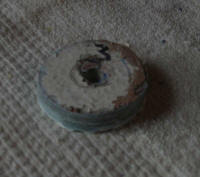
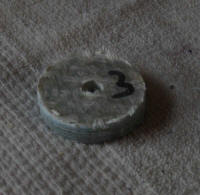
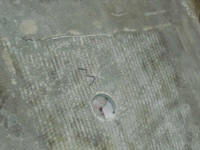 |
4: From fairly high in the topsides, forward
on the port side. Total thickness: 5/16" +.
Laminate relatively sound other than the innermost, exposed
layer. |
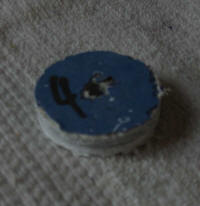
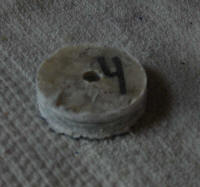
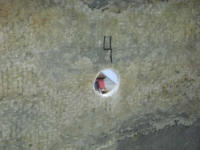 |
5: From the bottom, down near the turn of the
bilge leading to the keel deadwood, slightly forward of the
rudderpost. Heavily reinforced; total thickness about
7/8" +. Sample showed good condition with no problems. |
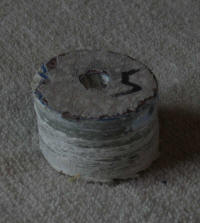
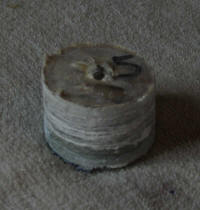
 |
6: Known bad location, already heavily ground
and thin sample anticipated. Total thickness:
3/16". Inner layer of roving delaminated from the
remaining outer layers during removal. |
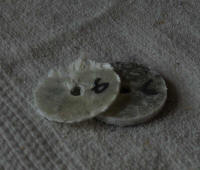
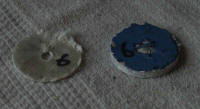
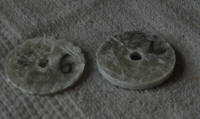
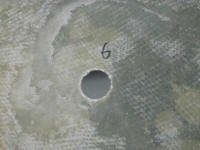 |
7: Known suspect location close to sample 6.
Similar sample condition. Total thickness: about
3/16". Inner 2+ layers of roving delaminated from
remaining outer laminate during removal. Gelcoat badly
charred on exterior. |
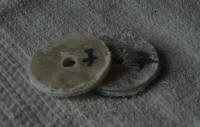
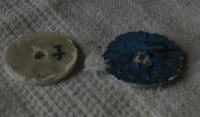
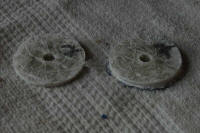
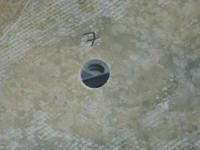 |
8: From higher in the topsides and nearby
samples 6 and 7. Total thickness: 1/2" +.
Inner 2+ layers of roving delaminated from remaining
laminate during removal, but bulk of laminate in this area
appeared sound. Slight beginnings of delamination of
skin coat from gelcoat on exterior. |
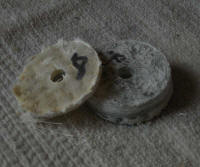
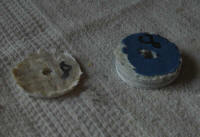
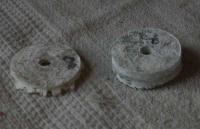
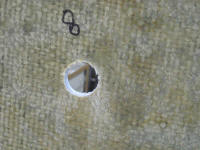 |
9: From well aft on the port side, closer to
the transom. Total thickness: 1/4".
Inner half of laminate delaminated from the outer half
during removal. Both halves appeared sound other than
the lack of bonding between the two sections. |
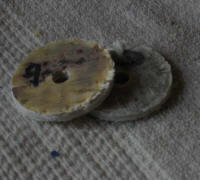
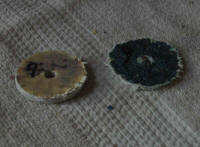
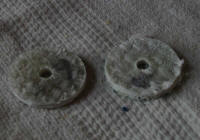
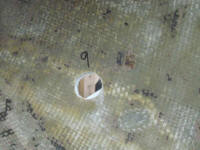 |
10: Taken from an area that had been heavily
ground, leaving only the skin coat and gelcoat. Total
thickness: 3/32". |
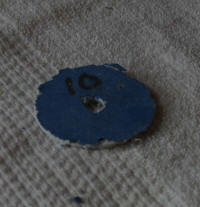
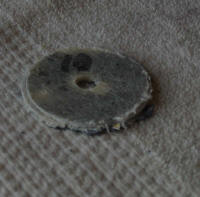
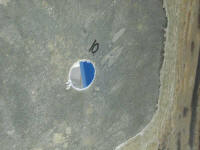 |
11: Taken close to the turn of the bilge
leading to the keel deadwood, and a few feet forward of
sample 5. Similar laminate thickness and condition.
Total thickness: 3/4" - 7/8". General good
condition other than appearance of the innermost (exposed)
layer. |
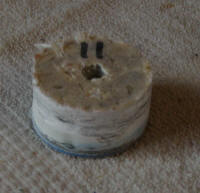
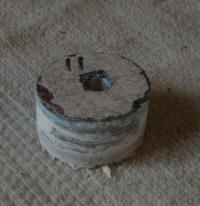
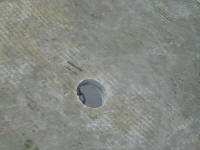 |
12: From a foot or so aft of the rudderpost,
port side. Total thickness: 5/8". Outer
2-3 layers delaminated from the remainder during removal.
Inner section in sound condition. Gelcoat and portions
of skin coat burned away during fire. |
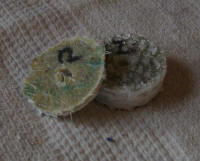
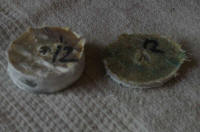
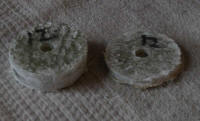
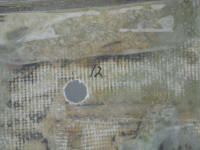 |
13A: From near the turn of the bilge to the
keel deadwood on the starboard side. Total thickness:
3/4" - 7/8". Generally sound throughout, but innermost
layer or two was partially delaminated from the remainder; I
pulled it apart after removal, though it didn't come apart
on its own. |
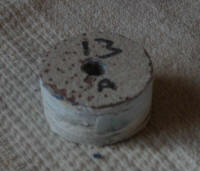
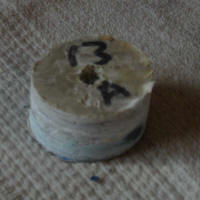
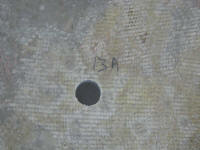 |
13B: From a known bad spot on the starboard
side where I'd already ground away much bad material.
Total thickness: 3/32"/ Badly charred exterior
gelcoat. |

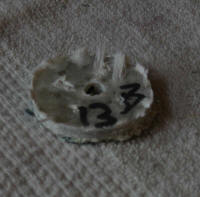
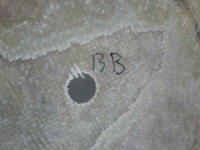 |
14: From a suspected bad spot high on the
starboard topsides, in an area known to be affected by heat
and fire. Total thickness: 1/4". Inner
layer of roving delaminated during removal. Gelcoat
completely burned away during fire, with exposed skin
laminate on exterior. |
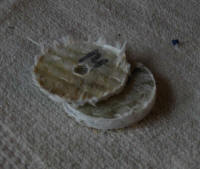
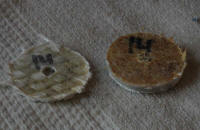
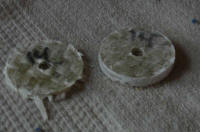
 |
15: From slightly further aft and lower than
sample 14. Overall condition surprisingly sound
despite obvious location in the path of the heat and fire
damage. Total thickness: 5/16". Gelcoat
burned away in the fire, exposing crystallized skin laminate
layer. |
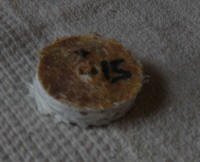
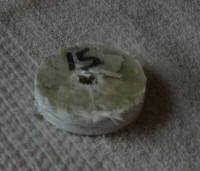
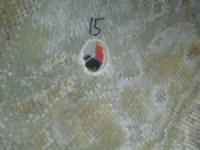 |
16: From a marginal, heavily-ground section of
the starboard side. Total thickness: 1/4".
Laminate generally sound, though clearly much thickness has
already been removed. Gelcoat burned away in the fire;
exterior portion ground away during destructive testing by
previous ownership. |
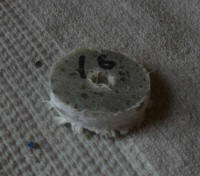
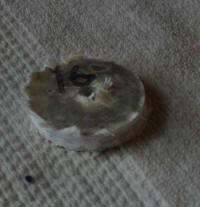
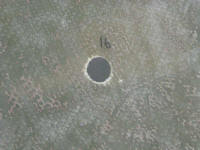 |
17: Same as sample 16, from an area a couple
feet removed from 16's location. |
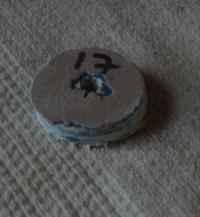
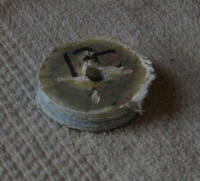
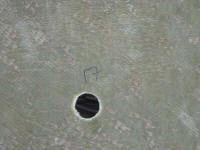 |
18: From high in the topsides on the starboard
side, several feet forward of sample 14. Total
thickness: 3/8". Gelcoat charred and cracked on
exterior, but this sample comes from the forwardmost limit
of visible fire damage and acts as a sort of control.
Laminate observed to be generally sound. |
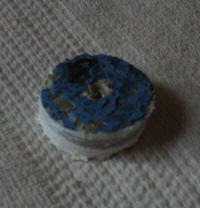
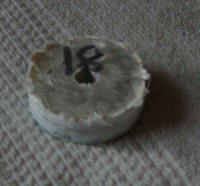
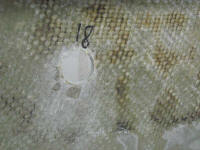 |
19: From well aft on the starboard side, aft
of the position of the mizzen chainplate location and a foot
or two closer to center line from sample 15. Total
thickness: 5/16". Laminate generally sound with
exterior damage from fire (gelcoat completely burned away,
exposed skin laminate). |
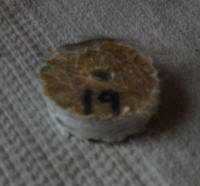
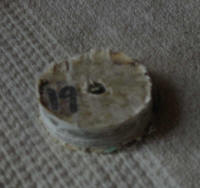
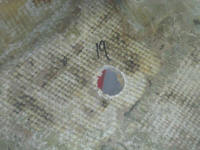 |
20: From further aft than sample 19, and
higher in the topsides. Total thickness: 3/8".
Laminate generally sound other than obvious external fire
damage. |
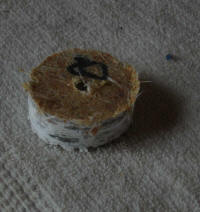
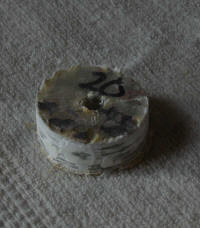
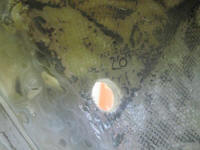 |
Total Time Today: 1.5 hours (sampling); 1 hour
to inspect core samples for this writeup |
Previous |
Next |
|